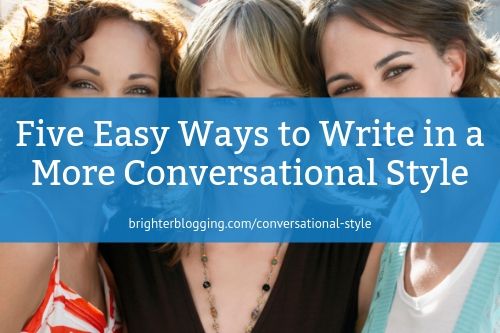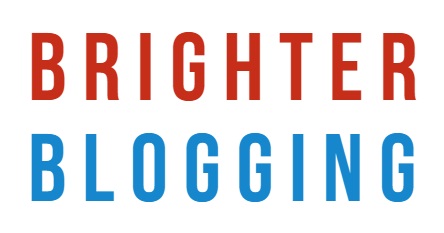Five Easy Ways to Write in a More Conversational Style

If you’re a blogger, you’ve probably been told at some point that you should “write in a conversational style.”
You may be wondering what exactly this means, and whether it’s even something you’d want to do.
Real life conversations, after all, have a lot of features that don’t seem to support good writing. In a conversation with friends, you might:
- Jump around between different topics
- Take a while to get to the point
- Use in-jokes (where an outsider wouldn’t get the joke)
- Trail off or get distracted from what you were saying
A disjointed, rambling blog post full of references that no-one will understand isn’t going to win a lot of love from readers.
So what do bloggers (and editors and publishers) mean when they ask for a “conversational style”?
They’re looking for writing that has the flavour of a real conversation without attempting to replicate it. In particular, they’re looking for writing that’s not too formal, that addresses the reader directly, that shows a light sense of humour, and that’s written in a way that’s easy to engage with.
I’m going to take you through some key ways to write in a conversational style … with concrete examples of how you can achieve each one.
#1: Staying Fairly Informal
Conversational writing is fairly informal writing. I like to think of it as if I’m writing an email to a casual friend: I’d make it grammatical and coherent, but I wouldn’t be stuffy about it.
Two easy ways to make your writing more informal are to:
- Use contractions (e.g. “don’t” for “do not”, “I’m” for “I am”)
- Use regular, everyday language (e.g. “saw” rather than “observed”; “get” rather than “obtain”)
Examples:
“So, yeah. I think email marketing is kind of important. And you should, too.”
– from 5 Ways to Build an Email List, Jeff Goins, Goins, Writer
“Afraid you’re an impostor? Suddenly, you think that if you were a real writer, your characters would be perfect. Worried that published authors don’t ever get rejections? Think again. That’s just your confirmation bias being a bit of a snit.”
– from How to Make Tough Feedback Work for You, Lauren Mead, Write to Done
#2: Talking Directly to the Reader
Conversations require more than one person … and this is something you can use in your blog posts (or articles, or book chapters). Write as if you’re talking directly to your reader: this comes across as friendly and immediate. Address them as “you”, as though you’re in the room with them, or sending them an email.
(Note: I normally avoid the plural “you”, because although you — hopefully! — have more than one reader, they’re each experiencing your post individually. Occasionally, the plural “you” can make sense too, though.)
Examples:
“Take the time to examine your scenes carefully for description of characters and settings. Make sure you include details that will bring your scene to life and that come through the senses and emotions of your POV character.”
– from Description Errors That Result from POV Limitations, C.S. Lakin, Live Write Thrive
“All writers make errors and can benefit from an extra set of eyes. And editing tools don’t take the personality out of your work – they simply give you an informed set of options that you can engage with and decide if they fit your work.”
– from 3 Solid Reasons Every Writer Needs to Use an Editing Tool, Hayley Milliman, The Write Life
#3: Bringing in Personal Experience
While this isn’t something you have to do to achieve a conversational style, I find it often helps to bring in some of your personal experience with the topic at hand.
That could be something as simple as a single sentence — it doesn’t need to be (and generally shouldn’t be) a long anecdote.
Just like using “you”, using the word “I” helps to draw a closer connection between you and the reader.
Examples:
“I can’t remember a time when stories weren’t intertwined, in some way or another, with every part of my life. When I was young, it was effortless. I breathed stories, lived stories. I romped through them with a delightful lack of control, since I wasn’t yet actually requiring myself to write them.”
– from Taking Your Writing to the Next Level: Whole-Life Art, K.M Weiland, Helping Writers Become Authors
“My brother and I weren’t “free-range” children, by any means, but we were carefree and even a little bored every now and then. There were homemade popsicles and unprofitable lemonade stands; there was digging for rocks in the bottom of the creek bed; there was riding the tire swing like there was nothing more important in the world.”
– from How to Give Your Kids the Gift of Independence This Summer, Heidii McMichael, A Fine Parent
#4: Having a Sense of Humour
I’m not a naturally funny person and I sometimes have to make an effort with this one! But a little bit of humour can make your writing more engaging and accessible. You don’t have to crack jokes – you might gently poke fun at yourself, for instance.
Examples:
“There’s only one you. You have unique DNA. Your hopes, thoughts, and dreams are unique. Even the face you make when you accidentally walk into a spider web is unique.”
– from How to Become a Better Writer: 14 Tips to Up Your Writing Game in 2019, Kevin J. Duncan, Smart Blogger
“(OK, marketers, here’s where you can have your virtual tomatoes at the ready for what I’m about to say …) I don’t think there is such a thing as B2B marketing.”
– from It’s the 21st Century: B2B Needs to Be Fun(ner), Karine Bengualid, Copyblogger
#5: Being Open to Responses
In a conversation, you (hopefully!) don’t do all the talking.
One simple way to make your posts more conversational is to ask for responses: to invite comments where readers can tell you what they think about a particular topic.
Like most bloggers, I tend to do this with an explicit invitation at the end of the post (and you’ll see one in a moment!) – but sometimes it can be helpful to pave the way for comments earlier on. This could mean writing something in your introduction like, “I’m sure I don’t have all the answers – so as you read through, if you feel that I’ve missed something out, do share it in the comments.”
Examples:
“Since I’ve paid the price for the “have the trust conversation sooner” lesson many times, I thought sharing my experience might be helpful to you. Plus, you can avoid the painful cost of trust fallout. What guidelines do you use to help facilitate trust conversations?”
– from 5 Ways to Have that Trust Conversation Sooner, Charlie Gilkey, Productive Flourishing
“Please take a few minutes to leave a comment below with your (hopefully resolved!) copycat stories and any advice you have for anyone who is in this situation right now. Oh, and if you have any questions about building moats or being strategic about your business, ask away!”
– from How to Stay Ahead of Competition and Copycats, Nathalie Lussier, NathalieLussier.com
So, over to you … what would you consider to be hallmarks of “conversational” writing? Do you deliberately try to make your own writing conversational – and if so, how do you do that? I’d love to hear your thoughts in the comments below.
